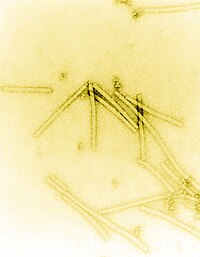
Photo from wikipedia
Equine parvovirus-hepatitis (EqPV-H) is one of the etiological agents of Theiler's disease, causing fulminant hepatitis; however, its transmission route and pathogenesis remain unclear. In the present study, we aimed to… Click to show full abstract
Equine parvovirus-hepatitis (EqPV-H) is one of the etiological agents of Theiler's disease, causing fulminant hepatitis; however, its transmission route and pathogenesis remain unclear. In the present study, we aimed to determine EqPV-H shedding in oral/nasal/vaginal swabs or semen samples from horses living in Korea using nested polymerase chain reaction. We then used the data obtained to investigate various risk factors associated with EqPV-H including viral shedding, hepatopathological changes, and genetic diversity. Our data revealed occurrence of EqPV-H shedding in these animals (oral: 3/102, 2.9%; nasal: 3/102, 2.9%; semen: 1/9, 11.1%) and identified that both age and country of foaling were significantly associated with EqPV-H shedding (P < 0.05). In addition, we noted that one of the newly isolated strains clustered separately from the other strains in the phylogenetic tree, revealing unique nucleotide and amino acid substitutions. This is a field surveillance study providing evidence of natural and venereal shedding of EqPV-H and describing its presence in both oral/nasal fluids and semen. This epidemiological and clinical analysis may help specify the clinicopathological features of EqPV-H and facilitate the development of novel disease prevention strategies. This article is protected by copyright. All rights reserved.
Journal Title: Transboundary and emerging diseases
Year Published: 2022
Link to full text (if available)
Share on Social Media: Sign Up to like & get
recommendations!